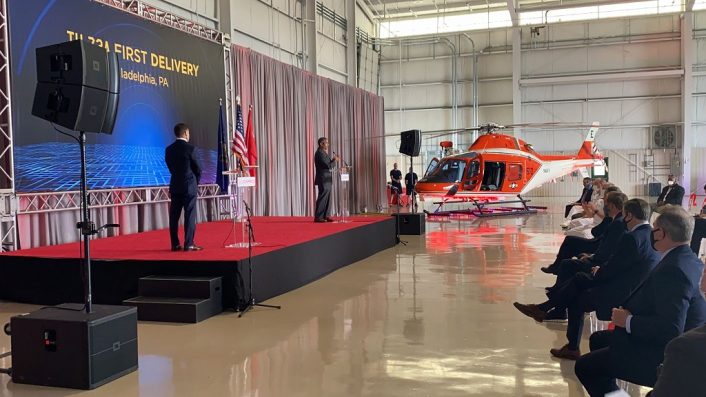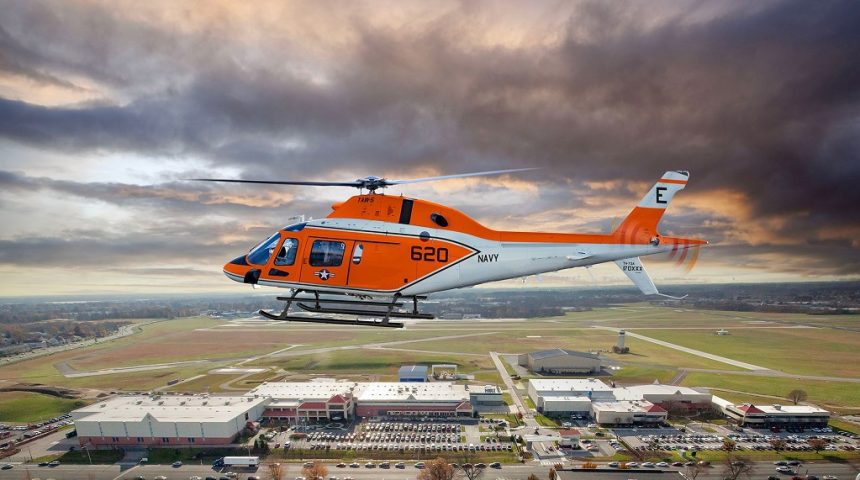The new helicopter will replace the TH-57 Sea Ranger, allowing the introduction of a modernized training curriculum for the highest quality of training.
The U.S. Navy took delivery of the first new TH-73A training helicopter during a ceremony at Leonardo’s facilities in Philadelphia, Pennsylvania, on June 10, 2021. The helicopter is the first of the 32 acquired through the initial 177 million USD firm-fixed-price contract awarded last year, out of a total requirement of 130 aircraft that will be delivered through 2024 to replace the ageing TH-57 Sea Ranger a military derivative of the famous Bell 206 Jet Ranger, after 35 years of service. Towards the end of 2020, the U.S. Department of Defense exercised options for an additional 36 aircraft in a $171 million fixed-price-contract.
“The TH-73A will be instrumental in providing higher fidelity training to our future rotary-wing and tilt-rotor aviators for the Navy, Marine Corps and Coast Guard,” said Vice Adm. Kenneth Whitesell, Commander, Naval Air Forces. “The cutting-edge technology and advanced avionics within the Advanced Helicopter Training System (AHTS) will enable a more seamless transition from the training aircraft to fleet aircraft, this in turn allows more focus on high end warfighting development and training.”
The new Advanced Helicopter Training System (AHTS) of the U.S. Navy includes not only TH-73A helicopters, but also new simulators and aircrew training services, a modernized curriculum and a new contractor logistics support contract for the maintenance and flight line support requirements of the new helicopter. The TH-73A, based on the Instrument Flight Rules (IFR) certified variant of the popular commercial AW119Kx, has been fully certified by the Federal Aviation Administration (FAA) prior to delivery, thus bringing a ready-made solution that will transition the TH-57 platforms out of service by 2025, with the first helicopters expected to be retired during fiscal year 2022.
We proudly present @USNavy their first purpose built, mission driven and American-made #TH73! pic.twitter.com/XjDy9JPkaZ
— Leonardo Helicopters (@LDO_Helicopters) June 10, 2021
“This delivery signifies a new era for Naval Aviation training,” said Rear Adm. Robert Westendorff, Chief of Naval Aviation Training. “By using current cockpit technologies and a new training curriculum, the TH-73A will improve pilot training and skills, and ensure rotary wing aviators are produced more efficiently at a higher quality and are ready to meet the fleet’s challenges.”
The first TH-73A will be used to train the cadre of instructor pilots and validate the modernized curriculum efforts, which is a requirement prior to begin the training of Student Naval Aviators with the new curriculum in the new system. The AHTS has capacity to train several hundred aviation students per year at Naval Air Station Whiting Field-South (Florida), where all student helicopter pilots for the Navy, Marines and Coast Guard train along with several NATO-allied nations, accounting for the training needs of all of the Fleet Replacement Squadrons and setting up for success the students in any platform they select after the TH-73A.

“The U.S. Navy expects the highest quality of training for its future aviators,” said Gian Piero Cutillo, Leonardo Helicopters Managing Director in the press release. “We are honored to start delivery of the product chosen for this critical task. Today is just the beginning of a journey we have undertaken to support the Navy as it shapes the capabilities of future generations of aviation students.”
To support the new TH-73A fleet, Leonardo has announced the construction of a new comprehensive 100,000 sq. ft. helicopter support center at Whiting Aviation Park, located directly across the runway from NAS Whiting Field for seamless and immediate maintenance and repair support, with groundbreaking expected in December 2021. This way the company will be able to efficiently support the U.S. Navy throughout the entire service life of the TH-73A until 2050 or longer.
“The combined government and contractor team set new standards to meet much needed requirements in the fleet,” said Capt. Holly Shoger, Undergraduate Flight Training Systems Program (PMA-273) program manager. “We are proud to develop and provide these new capabilities that will improve pilot training for many years to come.”
— flynavy (@flynavy) May 13, 2021
Following the delivery, the first TH-73A will undergo the final DoD inspections before its arrival at NAS Whiting Field. According to the Naval Air Systems Command (NAVAIR) press release, all the first 32 TH-73As are scheduled for delivery to the U.S. Navy this calendar year. The new helicopters will be housed in a temporary hangar until a new dedicated helicopter maintenance hangar is built, with construction to begin in 2023.
The TH-73A, initially proposed as TH-119 to the US Navy, is based on the commercial AW119 “Koala” and is powered by a Pratt & Whitney Canada PT6B-37A engine, with a takeoff power rating of 1,002 hp and a maximum take-off weight of 6,283 lb (2,850 kg). In terms of flight performance, the TH-73 will be similar to the commercial AW119, with a cruise speed of 130 kt, 1,800 ft/min sea level rate of climb, hover in-ground-effect of 11,000 ft, service ceiling of 15,000 ft and a range of 515 NM. With these characteristics, the TH-73A will be able to be employed for both initial training flights and advanced training, as it can perform every maneuver in the U.S. Navy’s training syllabus for a seamless transition from basic maneuvers to advanced operational training.
The cockpit features an avionic suite made by Genesys Aerosystems, with four 6- by 8-inch displays, instrument-certified dual GPS/WAAS navigation system, synthetic vision system, Helicopter Terrain Avoidance Warning System (HTAWS), moving map and integrated communication and navigation systems. As already mentioned, the helicopter was also certified for IFR (Instrument Flight Rules) flight by the FAA. An increased level of security is provided by dual safety and hydraulic system.









